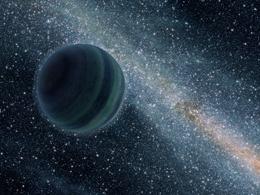So many lonely planets with no star to guide them
Our Galaxy may be full of worlds without a sun to call their own.
 Free-floating planets may be more common in our Galaxy than stars.NASA/JPL-Caltech/R. Hurt"
Free-floating planets may be more common in our Galaxy than stars.NASA/JPL-Caltech/R. Hurt""This is an amazing result, and if it's right, the implications for planet formation are profound," says astronomer Debra Fischer at Yale University in New Haven, Connecticut.
To find the wanderers, scientists turned their telescopes towards the Galactic Bulge surrounding the centre of the Milky Way. Using a technique called gravitational microlensing, they detected 10 Jupiter-mass planets wandering far from light-giving stars. Then they estimated the total number of such rogue planets, based on detection efficiency, microlensing-event probability and the relative rate of lensing caused by stars or planets. They concluded that there could be as many as 400 billion of these wandering planets, far outnumbering main-sequence stars such as our Sun. Their work is published today in Nature1.
Unexpected bounty
Study author Takahiro Sumi, an astrophysicist at Osaka University in Japan, says the deduced number of homeless exoplanets surprised him. "The existence of free-floating planets has been predicted by planetary formation theory, but nobody knew how many there are," he says.And because current theories of planet formation hold that lower-mass planets are more readily flung from developing planetary systems than are higher-mass planets, there could be a huge number of lighter planets on the loose. "They might be littering the Galaxy," says Fischer.
Sumi and scientists from the Microlensing Observations in Astrophysics (MOA) and Optical Gravitational Lensing Experiment (OGLE) collaborations used gravitational microlensing to detect the planets. Microlensing involves measuring changes in the brightness of distant, background stars as a passing planet's gravity bends and magnifies the starlight. As a result, the star brightens and fades in a pattern distinct from random twinkling, and the duration of brightening indicates the mass of the magnifying object.
Gregory Laughlin, an astronomer at the University of California at Santa Cruz, says the authors have done a good job of ruling out other possible explanations for the light-distorting objects. But he adds that it's difficult to speculate about the number of unbound, lower-mass planets on the basis of the wandering Jupiters, because that assumes that they were formed by a similar mechanism to planets in our neighbourhood. "I think we might be seeing a different formation mechanism here, something more similar to that of a tiny star than a giant planet," he says. "But that's just a hypothesis."
Life on the road
Planetary scientist David Stevenson at the California Institute of Technology in Pasadena has considered how the temperatures on ejected planets might compare with those on star-bound bodies2. If Jupiter were kicked out of the Solar System, its surface temperature would drop by only about 15 kelvin, he says – although it would still be unsuitable for supporting life. However, "when you eject a planet that is quite massive, it could have carried along an orbiting body", Stevenson adds. "And that might be a more attractive possibility for life."Unbound Earth-mass planets might still be capable of carrying liquid water, Stevenson says, even in the frozen reaches of interstellar space – as long as they have a heat-trapping hydrogen atmosphere. "That can bring the surface temperature up to 300 kelvin [about 27 °C]," he says. "And then you can have oceans."
Study author David Bennett, an astrophysicist at the University of Notre Dame in Indiana, agrees that life could exist on these wandering worlds. He says that the next steps in the search include confirming the absence of host stars and looking through new data for the footprints of smaller, Saturn- or Neptune-mass planets.
In the future, drifting Earth-mass planets could be detected using NASA's planned Wide-Field Infrared Survey Telescope (WFIRST), a space-based telescope capable of resolving the more rapid bright blips associated with lower-mass objects. "Detecting Earth-mass unbound planets?" says Scott Gaudi, an astrophysicist at the Ohio State University in Columbus. "That would be very interesting."
No comments:
Post a Comment